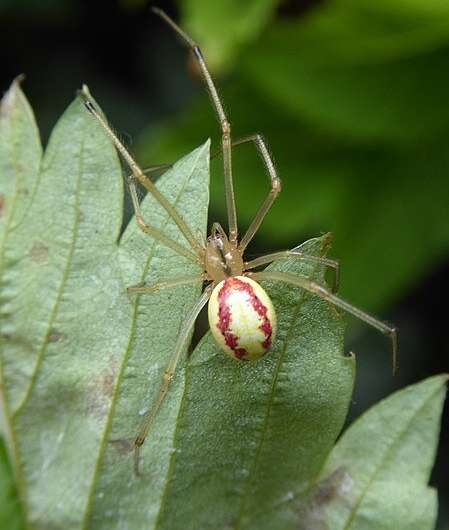March 13, 2023 report
This article has been reviewed according to Science X's editorial process and policies. Editors have highlighted the following attributes while ensuring the content's credibility:
fact-checked
peer-reviewed publication
trusted source
proofread
Candy-striped spiders observed wrapping and killing sleeping prey at night
A pair of arachnologists with the University of Toronto Scarborough reports that in addition to its other ways of capturing and feeding on prey, candy-striped spiders also wrap up and feed on sleeping prey at night. In their paper published in the journal Ecology, Catherine Scott and Sean McCann describe their study of the predatory behavior of candy-striped spiders living on Vancouver Island in Canada.
Prior research has shown that candy-striped spiders, which look like candy jaw breakers with legs, capture prey using a web, similarly to other spiders. But they have also been seen stealing prey from other spiders. In this new effort, the researchers found that they also have another method of capturing and feeding on prey—sneaking up on them in the dark as they are sleeping and wrapping them in thread.
After noticing dead insects on plants while engaging in macrophotography at night, McCann teamed up with colleague Scott and the two of them ventured into the night to study the behavior of candy-striped spiders in action.
The pair found that things happened fast, which meant they had to use a high-speed camera. They found that the spider, which has poor vision, sensed a sleeping bug in a plant and climbed to it. Upon arrival, it sped into action, spinning thread around the bug, stopping occasionally to inject it with venom. Once the spider was convinced the prey was subdued, it began spreading digesting juices on parts of its exterior. Next, it chewed a hole through the prey's covering and proceeded to suck out a combination of juices and liquified meat.
To further test the spiders, the researchers captured some of them and placed them at the base of plants they knew were harboring sleeping insects. The spiders reacted as expected, climbing the stalks and encasing the prey. More surveillance showed that the spiders were capable of ballooning and rappelling between plants to get at prey. The researchers also found that that the spiders were not finicky eaters; they would wrap and dine on any insect of reasonable size. The pair note that the reason the tactic works is that it takes insects a moment to rouse themselves once asleep.
More information: Catherine E. Scott et al, They mostly come at night: Predation on sleeping insects by introduced candy‐striped spiders in North America, Ecology (2023). DOI: 10.1002/ecy.4025
Journal information: Ecology
© 2023 Science X Network





















